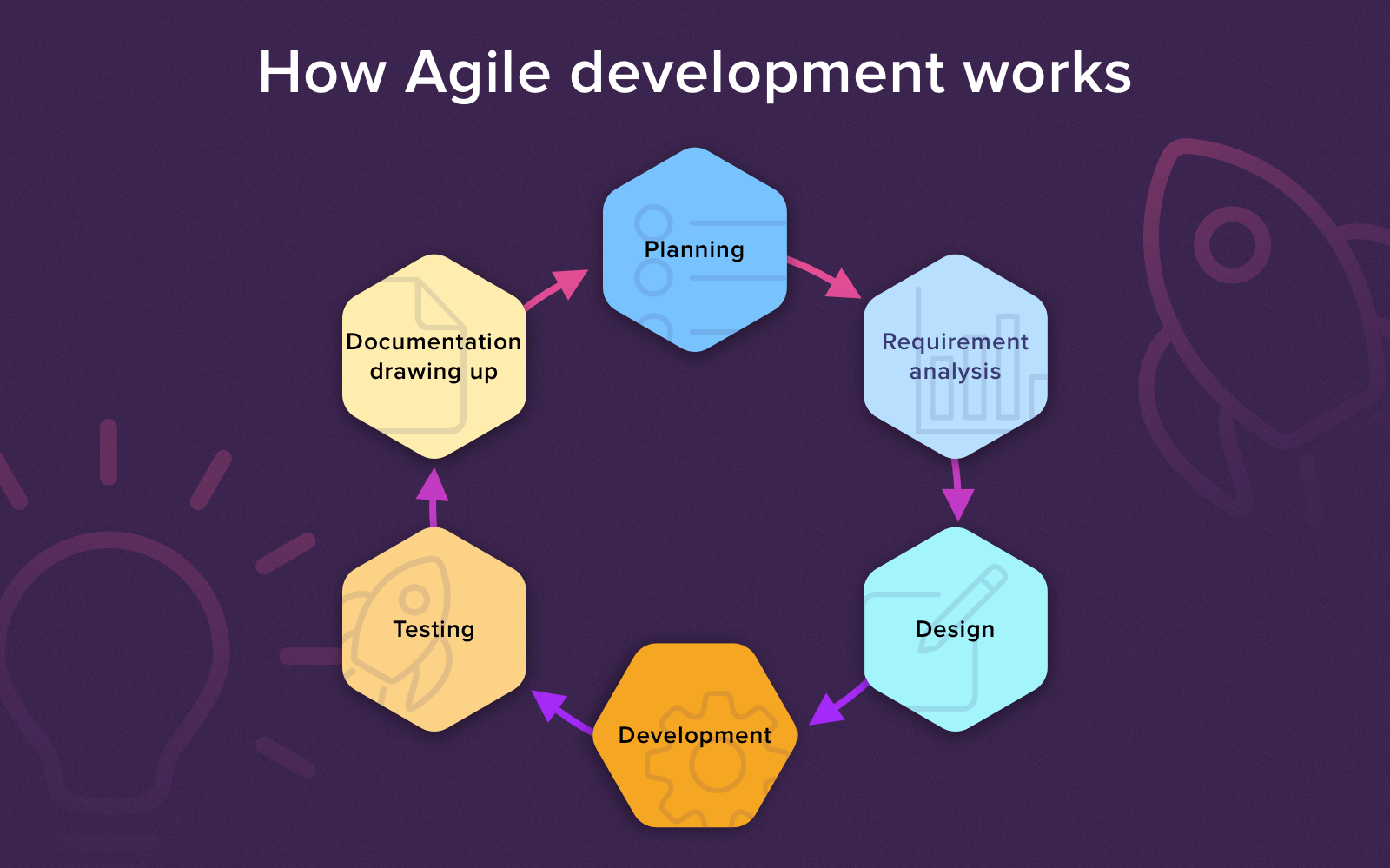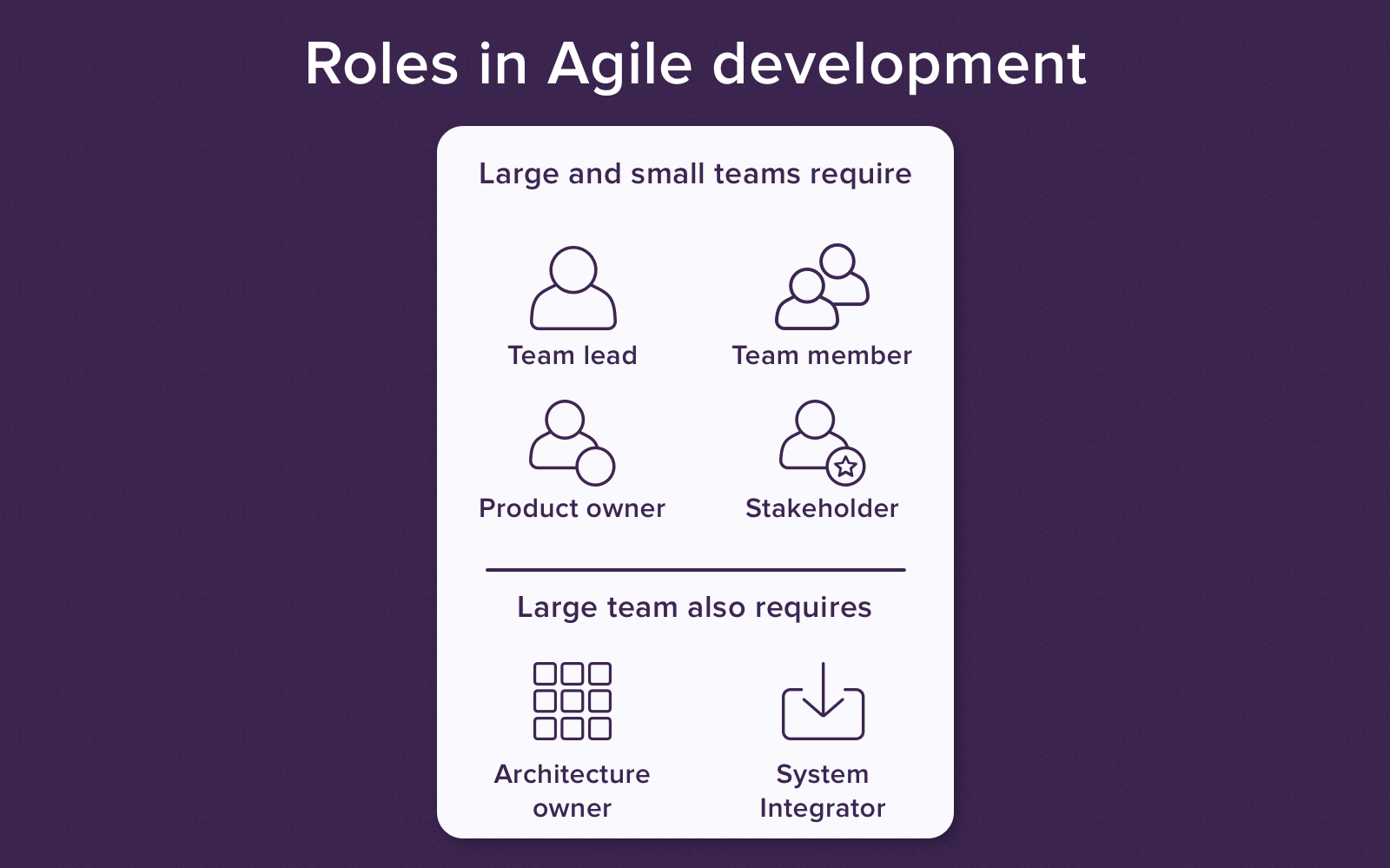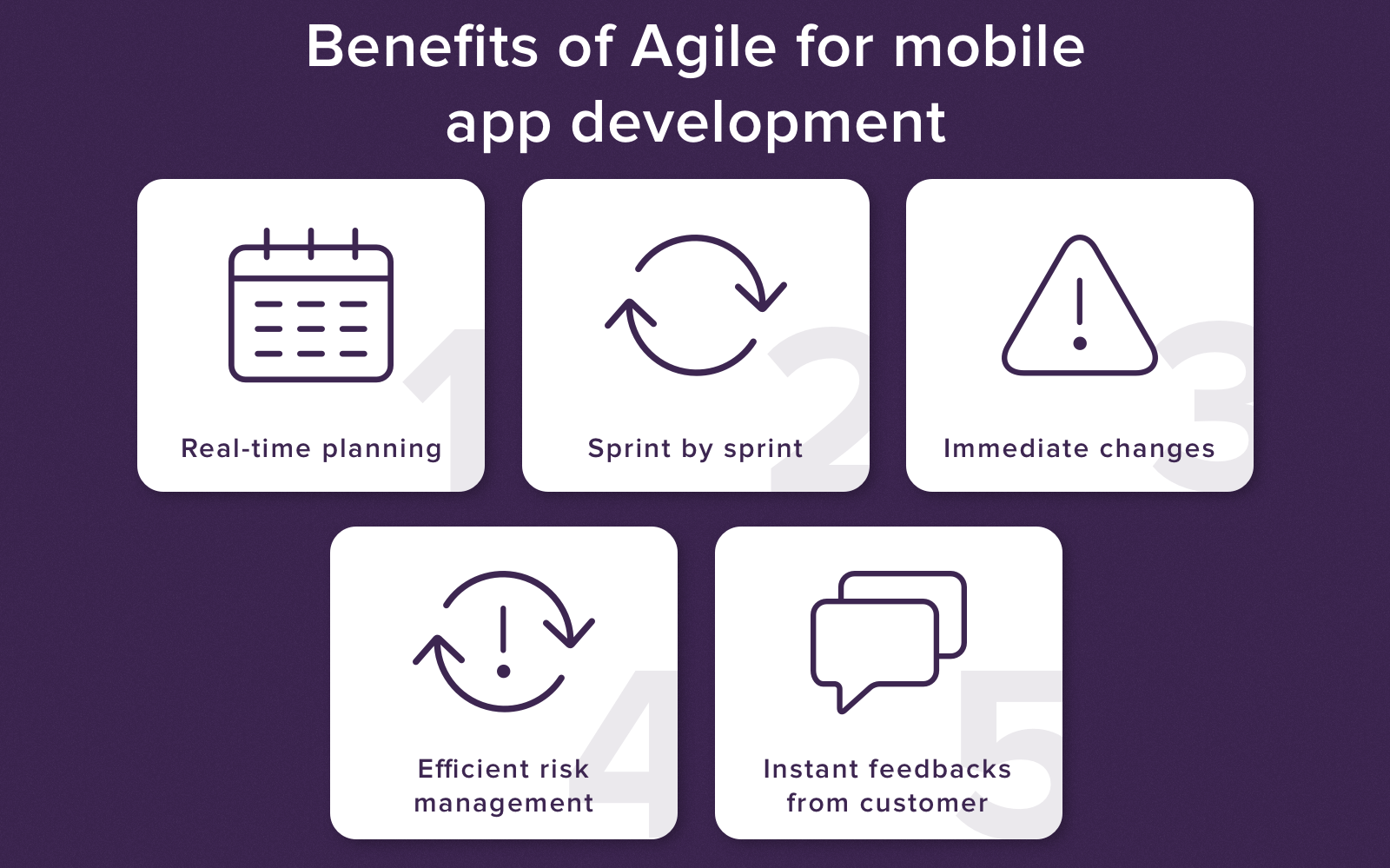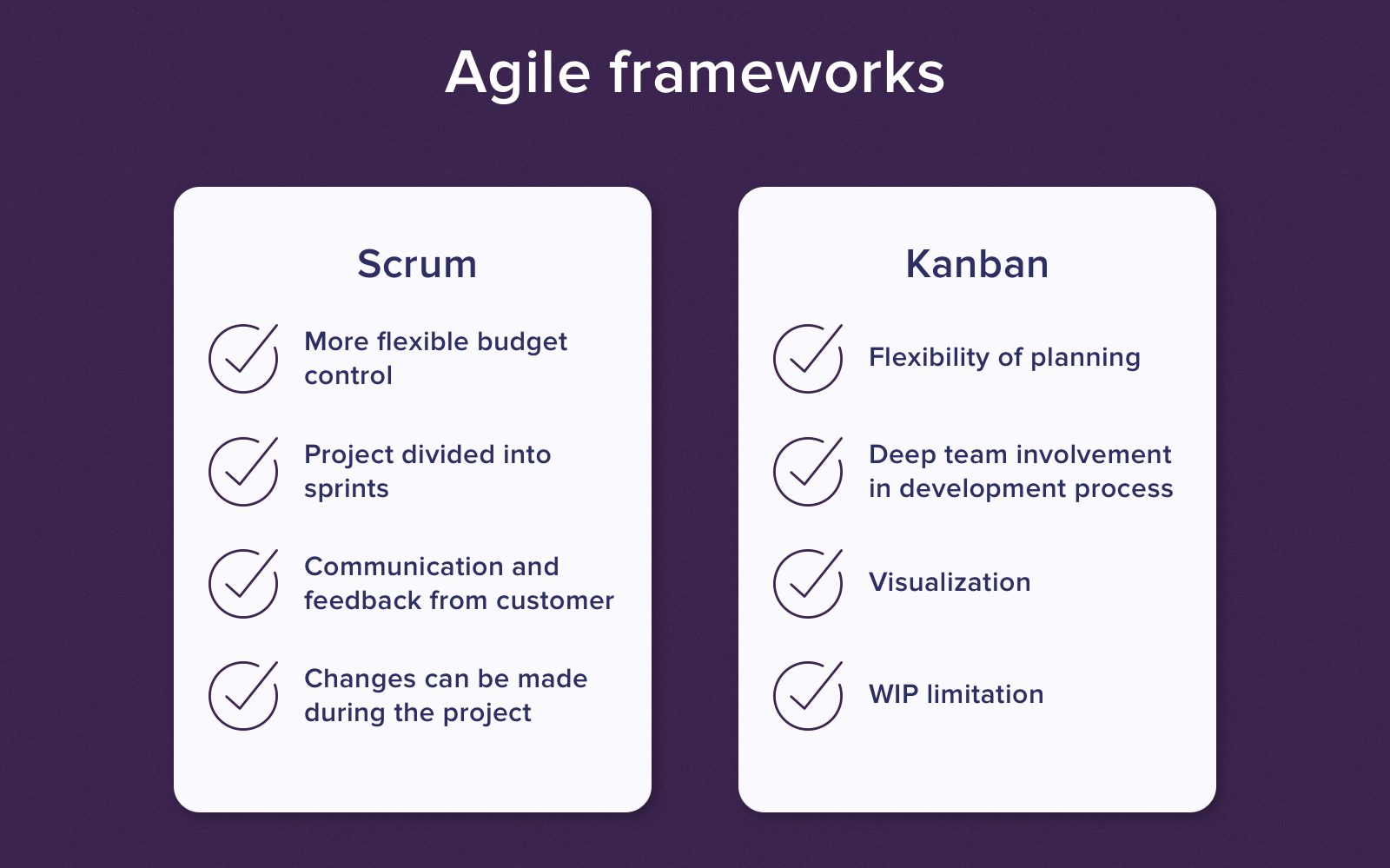Scrum And Agile Methodologies For App Design
Agile Application Development Methodology: How We Ensure App Quality
As you know, for sure, any kind of business you plan to do requires a due background, and it is impossible to create a top notch product if you don't prepare to it seriously. So, primarily, you need to start looking for a reliable IT vendor that offers high-quality app development services. Cleveroad as a development company also keeps up with this established truth, so we have a deliberate approach when we create your software. First, we choose the right development method that will make it possible to achieve a high result. And Agile methodology is the best option as we think.
You should know we create mobile apps using Agile methodology and how it helps us build a first-rate product.
What is Agile methodology?
In the beginning, we should explain to you what Agile methodology is more in detail and how it works.
Agile is iterative and step-by-step software development methodology. Agile application development helps organize designing and planning methods, development and testing methods during a software lifecycle. All methods of Agile are based on the following principles:
- quick response to any changes with the help of adaptive planning;
- joint elaboration of requirements;
- rationalization of tasks performed by development team;
- step-by-step software development with strict time frames.
This approach is used in many development projects of today.
Thus, Agile methodology allows specialists to manage work of development teams and organize their tasks efficiently. And this methodology is based on a democratical approach to the whole organization process.
How Agile works
Since Agile app development methodology consists of a few short cycles (2-3 weeks each), there is a risk minimization. A customer can see the result after each cycle, and he/she can request to make any changes. Thus, a customer has a direct influence on the development and he/she controls it. Each Agile application development lifecycle includes the following stages:
- planning;
- requirement analysis;
- design;
- development;
- testing;
- documentation drawing up.

Agile cycles and how it works
One cycle isn't enough for building a full-fledged product, but each iteration shows part of the functionality that can be tested and/or changed. After each cycle, development team sums everything up and can receive new requirements, then some adjustments can be made in software development plan.
We will tell you more about benefits of Agile for mobile app development, but first, let's define all roles in Agile teams and who is who.
Agile development roles and responsibilities: from small to large teams
Depending on a company and particularities of specific projects, names of roles can be different. And each employee of the company can bear one or that role, if necessary. Depending on the size of the project, the number of roles may vary. I will single out main Agile roles and responsibilities we use at Cleveroad at small teams first:

Agile small and large team roles
Team lead
In the case of Agile methodology, this role has nothing in common with a team lead in project management or web development department. Here team lead is the person that should control the team, manage resources, and prevent possible risks. As a rule, a project manager is the one who is at the wheel of this process. Also, this role is referred to Scrum master.
Team member
This is as simple as it can be - programmers, QA engineers, UI/UX designers and other people that take part in the development of one specific project. They all are included in the list of team members and each of them is very important for successful implementation of the project.
Product owner
This role is used when we apply Scrum framework for Agile mobile development. The Product owner is the representative of customer's team that owns the product being developed. This individual is responsible for a final product, he should know what is the key goal of the product, what it should be. But PO is not the manager, he just describes all requirements and prioritizes the workflow.
Stakeholder
As usual, there are a few stakeholders in each project. Stakeholders in Agile methodology are all individuals interested in the end result. Whether it be people involved in the project, customers, future users and so on. Stakeholder has very extensive definitions in development methodology, but on the whole, a stakeholder is the one who wants the product to be developed in the most high-quality way.
These are the main roles a small development team should have in agile mobile app development process. As for large teams, they have the same roles plus two additional ones like:
Architecture owner
Specialists that should be responsible for right software architecture engineering, control the development of project architecture. They should be good at architecture engineering and in all related technical issues. Also, architecture owner plays a role of mentor for it's technical department. When large projects are developed, architecture owner role is necessary.
System Integrator
A specialist that helps make system integration after each sprint (this is how we call cycles) when a large team is working on a huge project. The larger team is, the more troubles it may have with the integration process.
Well, it's time to say a couple of words about advantages of Agile methodology.
Why Agile methodology is good for mobile app development
Now let's speak about the application of Agile in mobile app development and why use Agile methodology. What particularities do mobile apps have? Unlike conventional desktop applications for PC that may function for a few years without an upgrade, mobile apps should be much more flexible for users. Users' demands may change rather often, so app owners should update this app every time when it requires new changes. And what is the way to create a high-quality mobile app without additional revisions? Agile methodology is the option.

Why Agile helps us make a high-quality software
More thorough planning in real-time mode
It can be rather difficult to prepare a plan for the whole development process. Using Agile methodology for mobile application app development, we can prepare a plan for each cycle separately, we don't waste extra time and resources to fix any bugs since everything can be fixed after each stage of implemented functionality. So we can make a proper plan for each stage without any problems, and it will help us create a first-rate product. By the way, if you should also know how to arrange budget planning for your software project.
Let's sprint!
With the help of Agile, we create the software sprint by sprint, as we indicated before. We call each cycle as sprint since it is similar to run on a short distance. We don't aim to complete the project as quick as possible, we test and check functionality after each sprint to see whether it works properly or not. Besides that, with Agile we can keep up with more strict deadlines.
Quick changes - an outstanding result
Due to Agile methodology in mobile application development, it is very convenient to make changes in the app since it is divided into sprints. Thus, it will not have a negative impact on the development process, and changes can be made quickly. Because when the project is almost finished and some serious problems arise, revision can take much more time and money, so Agile methodology helps avoid such situations.
Manage all risks efficiently
Users won't use an app that doesn't function properly or it has many bugs. It will lead to a total failure of the app. That is why an app can be released step by step with Agile methodology, in the beta version first, to make it possible for users to assess an app and notify about any bugs if they find it. On the basis of it, developers can make all changes quickly, and all risks can be managed timely. Existing bugs will be detected as early as possible. You can see how we organize risk management when we create your app.
Always in touch with the customer
It is not an acceptable situation when a customer sees a result of the development in the end. If something doesn't meet expectations of a customer, it will be more difficult to revise the app, it will lead to additional costs and time, and, as a result, to a negative feedback from a customer. Agile methodology allows the development team to be always in touch with a customer, provide him/her with an app when each sprint is completed, and if we need to make any changes - we do it quickly without damaging development processes.
So, you can see main benefits Agile mobile app development methodology brings for mobile app development. Now, let's move to the most popular frameworks of Agile.
Agile frameworks used by Cleveroad
There are many Agile frameworks, but each of them should be used in the specific case. It is worth noting that we use only two Agile methodology frameworks and it is enough for us. They provide us with all necessary features. Check them out!

Main Agile frameworks we use at Cleveroad
Scrum
Each project has it's own team of specialists and there are two additional roles we wrote about above - product owner and team lead (scrum master). The first one connects a team with a customer and controls the projects. It is some kind of mentor. Scrum master helps PO organize business process like holding a meeting, solving common problems, team motivation and control how team members keep up with scrum approach.
Scrum approach divides the working process into equal sprints - their duration may vary, everything depends on the specific project. Before we start a sprint, it is necessary to draw up tasks for this sprint. When it is completed, all results are discussed. This method makes it possible to lower development costs and make management process more efficient.
Kanban
The goal of Kanban is to create balance indoors, i.e. in the development team. It helps avoid situations when developers can work 24 hours, but designers almost have no work to do.
All team is unified, Kanban has no specific roles like in Scrum. The business process is divided not into universal sprints, but it has implementation stages of different tasks like Planning, In development, Testing, Complete etc. Using Kanban framework, it is necessary to keep up with following principles:
- Visualization. All working items should be displayed in the type of graph or chart, it helps understand the workflow situation better;
- WIP limitation. WIP is a work-in-progress abbreviation. So Kanban makes it possible to create balance in load for team members;
As it was noted before, there are many other frameworks available, but Scrum and Kanban are the main we use at Cleveroad.
What are Agile principles the most important at Cleveroad?
There are a few Agile development principles and practices we always keep up with at Cleveroad when we create mobile apps using Agile methodology. We list all of them below.
Strict time control
It is highly necessary to control the time spent by developers for all tasks, it helps us understand how much time we need to reserve for that or another task. Thus, we can provide you with a high-quality product without disruption of deadlines.
Permanent communication
One of the most important things we never ignore is a regular communication with a customer during the development process. When each sprint is completed, we can share the functionality we've already implemented with a customer to get his/her feedback. We can timely implement new requirements quickly and coordinate all related issues. The opinion of a customer is very important for us.
Keeping up with deadlines
Both sprint and project deadlines should be kept up strictly. Our goal is to estimate the time for implementation of each sprint and the project in total. When we estimate the development of a mobile app, we consider additional risks, so we reserve enough time for it.
You can immerse more deeply in our development process. Watch this video below:
Development Process at Cleveroad: How We Create Software
Meetings
Regular meetings with a team facilitate the speed of development and they allow us to find out all nuances and issues related to mobile app development process. If something goes wrong, we can discuss it immediately and find a quick solution.
Reports
Our customer receives reports about the functionality every week or every 2 weeks, depending on our personal agreement. Thus, a customer can feel calm that the software is being developed and we don't stagnate.
Agile application development process bears a lot of advantages both for the development team and for customers. We can affirm it as we are highly experienced in it. The methodology makes it possible to build a mobile app that will be accepted by the public with admiration. The only thing you need is a high-skilled software development team that will turn your ideas into reality. Contact us if you need to create a mobile app. Also, subscribe to our blog and get hot newsletters!
Frequently Asked Questions
Agile is an iterative and step-by-step software development methodology. Agile application development helps organize designing and planning methods, development, and testing methods during a software lifecycle.
All methods of Agile are based on the following principles:
- Quick response to any changes with the help of adaptive planning;
- Joint elaboration of requirements;
- Rationalization of tasks performed by the development team;
- Step-by-step software development with strict time frames.
Agile app development methodology consists of a few short cycles (2-3 weeks each).
Each Agile application development lifecycle includes the following stages:
- Planning;
- Requirement analysis;
- Design;
- Development;
- Testing;
- Drawing up documentation
As the client sees the result after each cycle, they can request to make any changes. Thus, a client has a direct influence on the development and controls it.
- Scrum
Scrum approach divides the working process into equal sprints - their duration may vary from project to project. Before a team starts a sprint, they draw up tasks for this sprint. When the sprint is over, the team discusses the results.
- Kanban
The business process is divided not into universal sprints. Still, it has implementation stages of different tasks like Planning, In development, Testing, Complete, etc.
Rate this article!
2934 ratings, average: 4.57 out of 5
Give us your impressions about this article
Give us your impressions about this article
Scrum And Agile Methodologies For App Design
Source: https://www.cleveroad.com/blog/what-is-agile-methodology-for-mobile-development
Posted by: lindseysamot1957.blogspot.com

0 Response to "Scrum And Agile Methodologies For App Design"
Post a Comment